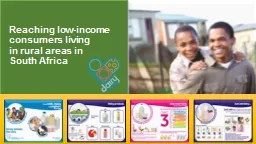

in rural areas in South Africa Message delivered by the trained Health promoter Aim of the presentation To demonstrate how to reach consumers living in rural areas REACH Low income consumer ID: 654599
Download Presentation The PPT/PDF document "Reaching low-income consumers living" is the property of its rightful owner. Permission is granted to download and print the materials on this web site for personal, non-commercial use only, and to display it on your personal computer provided you do not modify the materials and that you retain all copyright notices contained in the materials. By downloading content from our website, you accept the terms of this agreement.
Slide1
Reaching low-income consumers living
in rural areas in South AfricaSlide2
Message delivered by the trained
Health promoter
Aim of the presentation:
To demonstrate how to reach consumers living
in rural areas.
REACH:
Low- income
consumer
Government
c
linics.
CEP
Appoint service provider (HE)
Train HE and HP.Develop lesson planDevelop educational tools and aidsProvide the budget
Consumer education Project of Milk SA (CEP) to train
Health educators and health promoters
Health Promoter: Employed by
DOH
Health Educator: Contracted by
CEPSlide3
Size of the target population
Profile of consumer that should receive the message
.
Low-income consumer living in rural areas.
Settlements with less than 500 inhabitants
9 Provinces
3074 Clinics
52 DistrictsSlide4
Media usage
TelevisionRadio
Newspaper
One out of two adults use a cell phone
Limited smart phones
Television use by rural households in South AfricaSlide5
Low-income consumer living in rural or township areas
Regional obstacles
Far from major towns
Distance to travel to clinics or commodities
Lack of electricity and sometimes running water
Limited use of technologySlide6
Why should
health messages be delivered to low-income consumers?
Staple food is:
Maize meal porridge
Bread
Black tea with sugar
Poverty stricken
Poor nutritional status
Not enough knowledge to make healthy choicesSlide7
Message that is delivered
Value of dairy in the diet
Dairy is nutritional value for moneySlide8
Language – do not speak English
Illiterate – tailor-make leaflets
Often own their own cow, milk cow
Deliver hygiene and health messages
Have cultural beliefs of which some are about dairy
Teenage girls should not drink dairy as they become fertile at young age
Dairy gives worms (but actually due to poor hygiene conditions)
Lactose intolerance – avoid dairy because previous generations avoided dairy. Follow examples of the elderly (often self diagnosed)
Lack of refrigeration
Misperceptions about the role of coffee creamers-
use it as milk replacers for children
Technology is limited to cell-phones
Television popular, but electricity limited/expensive
What are the barriers to effective communication?Slide9
Reaching the group through trained health educators
Consumer Education
Project of Milk SA (CEP) provides training opportunity to train-the-trainer
CEP
Contract with service provider
that can overcome obstacles at rural level
Obstacles with Authorities
Sceptical towards ‘marketing activities’
messages
SA Food-based dietary guidelines
Balanced diet
Training by dietitian
Liaison with authorities:
Dept
of Health
District office
Dietitian of District officeSlide10
Training of Service
provider’s
Health Educators
Each HP responsible for one clinic in rural area
Train the Trainer
Training of DOH Health Promoters (
HP
)Slide11
Training of Service provider’s
Health EducatorsConsumer Education Project
Set goals per year
Develop communication messagesDevelop training aids
Train the Health educators Test health educators
Ensure present professional
Each HP responsible for one clinic in rural area
Train the Trainer
Training of DOH Health Promoters (
HP)
Trained by the CEP dietitian
and
Health Educators
Trained by CEP dietitian
– English
Trained by Health educator – vernacular languageDemonstration of presentation to HP
Message is repeated 3 timesSlide12
Usually grade 12 school level
(highest level)
Training in health issuesLimited knowledge of nutritionLanguage barrier – not fluent in EnglishLearning material simple and easy to understand
Teaching aids must be robust – withstand travel conditionsLack of use of technology
Mostly cell-phones – data costs moneyLimited knowledge of computersLack of access to computers
Cost of internetTravelLong distanceLack of transport
Expensive transport
Obstacles:
Profile of health promoter to deliver message to the
low-income consumerSlide13
Health promoter is equipped to deliver the dairy and health message to the low-income consumers.
Provided with:
Lesson plan and
PPT
Leaflets
A4
dairy clinic tool
Posters for clinic
Dairy-based nutrition booklet
Invest $30/person (
R400
ZAR
)Slide14
Program reach
44% of districts in SA
871 Nutrition advisors and Health promotersSlide15Slide16
Thank you for listening
Christine Leighton
christine@dairycep.co.za
www.rediscoverdairy.co.za